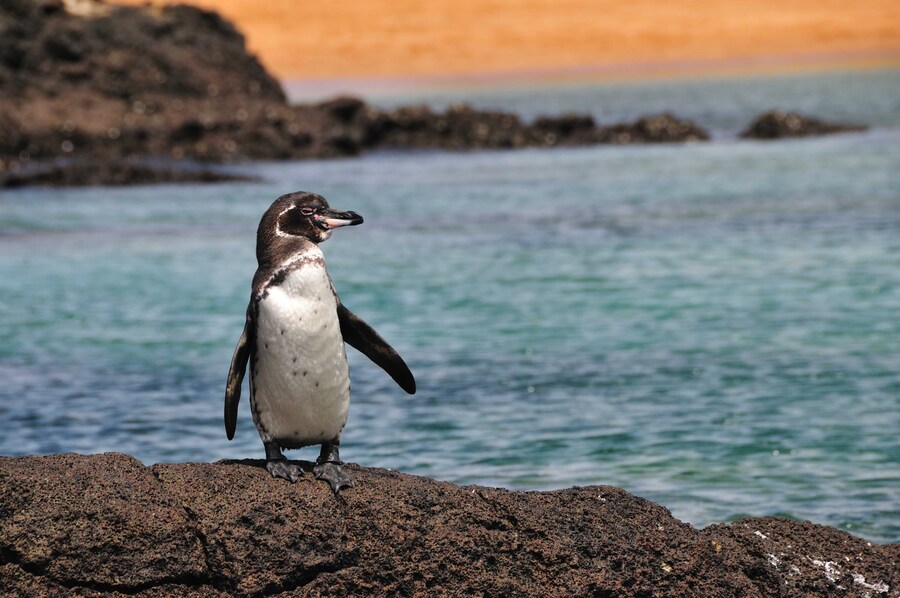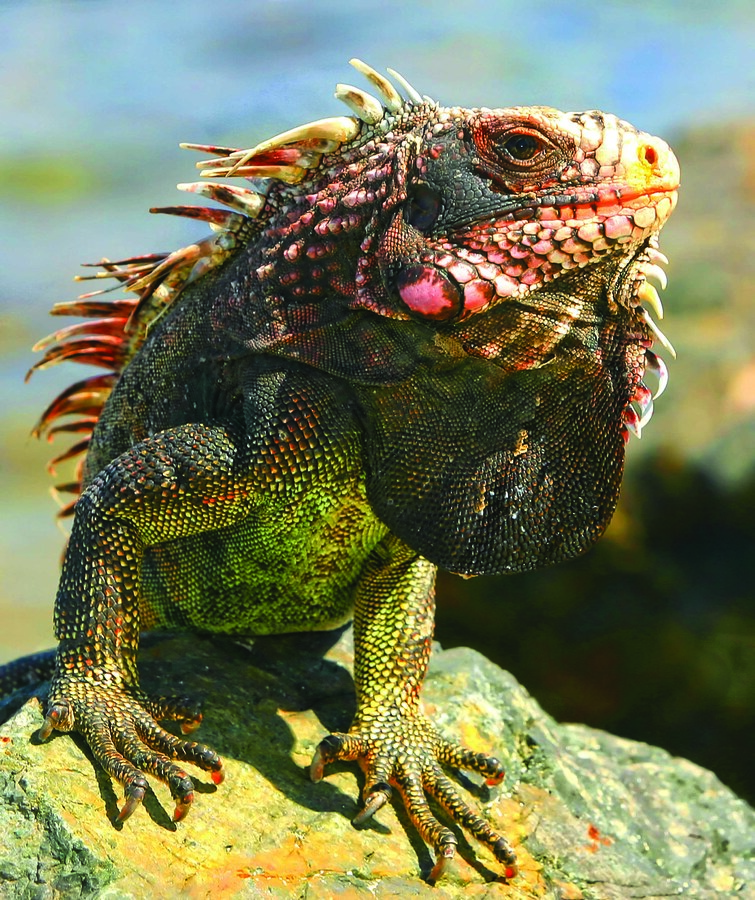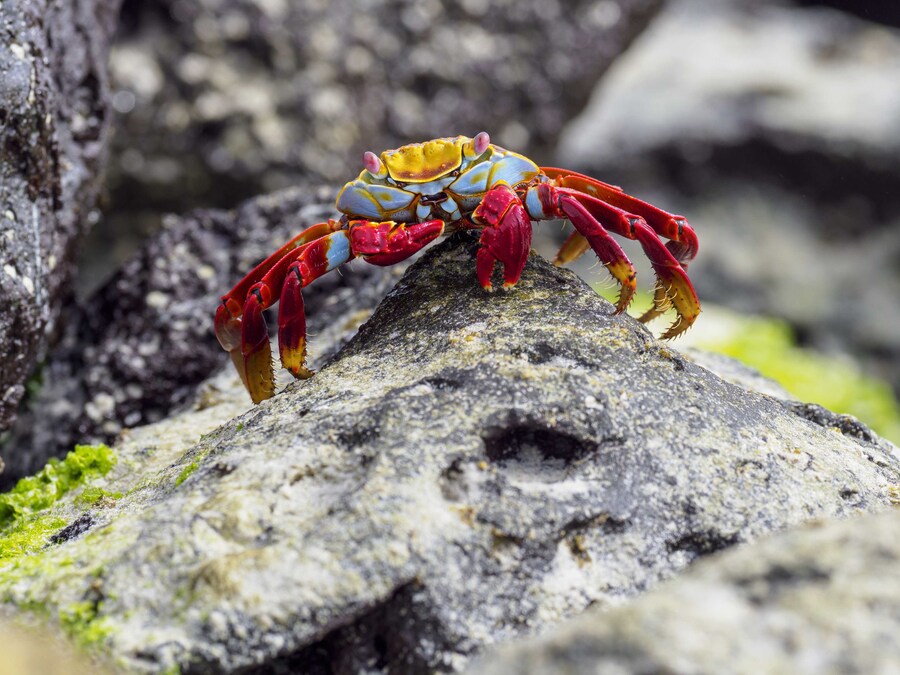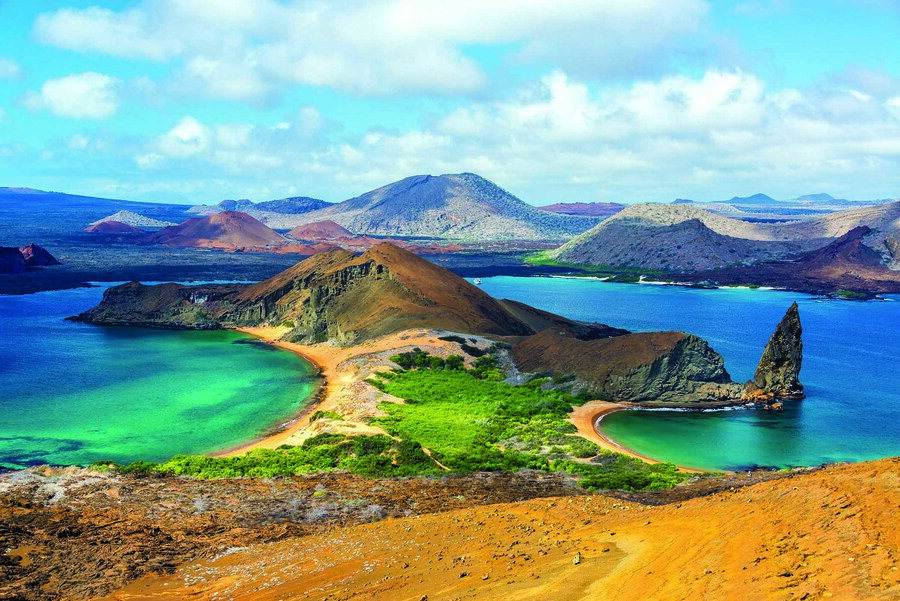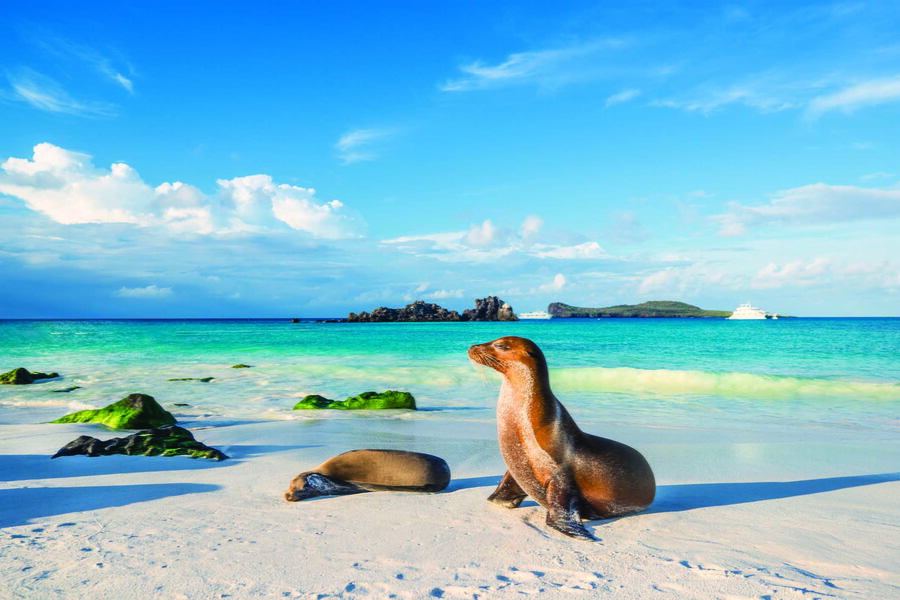

The Galapagos Islands are renowned for their unique wildlife. You can swim with sea lions, float eye to eye with penguins or stand beside a blue footed booby as is feeds its young. Spread out over 50 000 squares km of the Pacific Ocean, the archipelago comprises 13 main island and 6 smaller ones.
Inclusions
Round trip transfers
Domestic flights
Accommodation for 7 nights in Junior Suite Cabin onboard the Galapagos Legend
Accommodation for 3 nights in Quito and/or Guayaquil
Visits as per itinerary
Local English-speaking guide
Fuel surcharge
Migration control card
24 meals: 10 breakfasts, 7 lunches, 7 dinners
Exclusions
International airfare – Galapagos National Park fees $USD120 (US $ 200 starting from August 2024) – Optional excursions – Beverages – Gratuities to guides and hotels.
DAY 1 QUITO
Accommodation : Quito for 2 nights
DAY 2 QUITO
Meals : Breakfast
DAY 3 QUITO · GALAPAGOS ISLAND : BEGINNING OF YOUR CRUISE **
PM Highlands Tortoise Reserve (Santa Cruz Island)
Dry landing. In the mountains of Galapagos is possible to admire different kinds of birds, such as tree and ground finches, vermillion flycatchers, paint-billed crakes, yellow warblers, and cattle egrets (usually standing on the tortoises’ shell). The journey to the reserve offers great opportunities to see the contrasts that the island offers in reference to the variety of ecosystems. The road goes from the coast through the agricultural zone and straight up to the dense humid forests. Often, Galapagos Giant Tortoises are also seen on the way, wandering through pastures in the paddocks. This spot is a bird watchers’ haven since almost every land bird present on the island lives or migrates here.
Difficulty level: easy
Type of terrain: flat & muddy sometimes (depending on season)
Duration: 45 minutes drive / 1h30 walk
Meals : Breakfast, Lunch, Dinner
Accommodation : Standard Plus Cabin
DAY 4 GALAPAGOS ISLAND
Be marvelled at the variety of sea life that uses the crevices of the lava cliffs for shelter. Red-billed Tropicbirds fly overhead, switching between their nests and the bay, and a small colony of fur seals may be found near the landing site. You will be dropped off at a steep stairway that begins on rocks at the foot of a path that leads through a seabird colony full of Nazca and Red-footed Boobies. At the plateau, the trail continues inland allowing you to see more nesting booby colonies in the thin Palo Santo forest. Near the end of the trail, over a rocky lava plain, Wedge-rumped Storm-Petrels can be observed flying in all directions. If you are lucky, you may catch a glimpse of a Short-eared Owl.
Difficulty level: moderate
Type of terrain: rocky – lava
Duration: 45-minute walk
PM Darwin Bay (Genovesa Island)
Disembark onto a small sand and coral beach. A short trail heads west along a tidal lagoon and then up a rocky hill that leads to a point overlooking the cliffs and Darwin Bay. Along the trail near the tidal lagoon, visitors will see pairs of Swallow-tailed Gulls, Lava Gulls, Yellow-crowned and Lava Herons. The trail continues through Palo Santo trees, Opuntia cacti, and Saltbushes inhabited by Great Frigate birds and Red-footed Boobies. This is one of the few places in the islands where visitors are guaranteed to see Red-footed Boobies. It is estimated that more than 200,000 Red-footed Boobies live in the trees and bushes of Genovesa.
Difficulty level: Moderate
Type of terrain: Sand & Lava
Duration: 2 ½-hour walk aprox.
Meals : Breakfast, Lunch, Dinner
DAY 5 GALAPAGOS ISLAND
Sea lions, swallow-tailed gull and land iguanas are all present at the landing site. The small island is covered with a carpet of red succulent studded with Opuntia cacti. At the cliff edge, we spend time watching birds fly past at eye level in the updraught. These include frigatebirds, flocks of Galapagos shearwaters and of particular note, flights of displaying red-billed tropicbirds. Back at sea level, we once again encounter land iguanas, some of which have hybridized with their resident marine cousins.
Difficulty level: intermediate
Type of terrain: rocky
Duration: 2-hour walk
PM Santa Fe Island
Wet landing. Santa Fe shows white sand beaches surrounded by sea lion colonies; through the island path, an endemic cactus forest is passed, home the Santa Fe land iguanas (the largest in the islands). This island is the habitat for a number of species, including the Galapagos hawk, Galapagos snakes, rice rats (one of the few endemic Galapagos rodents), a variety of finches and one of the four mockingbird species of the archipelago.
Difficulty level: intermediate
Type of terrain: rocky
Duration: 1 ½-hour walk / 1-hour deep-water snorkeling
Meals : Breakfast, Lunch, Dinner
DAY 6 GALAPAGOS ISLAND
Wet landing. On the north side of Santa Cruz; behind the beach lies two small flamingo ponds were iguanas sunbathe, see coastal birds, Darwin finches, mockingbirds, and gulls, as well as interesting native vegetation like red and black mangrove, salt bushes. This beach is one of the main sea turtles nesting sites in the Galapagos.
Difficulty level: easy
Type of terrain: sandy
Duration: 1-hour walk / 1-hour snorkeling / beach time
AM Charles Darwin Research Station (Santa Cruz Island)
Dry landing. We visit the Station where the Galapagos giant tortoise breeding program takes places as part of our efforts to preserve the fragile Galapagos environment and where the famous Lonesome George (the last surviving specimen of his species) lived for decades.
Difficulty level: intermediate
Type of terrain: flat
Duration: 1 ½-hour visit
PM Mosquera Islet
Wet Landing, Mosquera Islet is located between North Seymour and Baltra Island. This flat, sandy island has a large colony of sea lions. It is also an excellent site to observe shorebirds such as herons and lava gulls. There is no trail on the islet, the visitor can enjoy the open area. Most of the islet is covered with sand and barren lava rock. Very little sesuvium portulacastrum plants grow on the sand.
Difficulty level: easy
Type of terrain: sandy
Duration: 1 ½-hour walk & snorkeling
Meals : Breakfast, Lunch, Dinner
DAY 7 GALAPAGOS ISLAND
Wet landing. Egas Port is a black volcanic sand beach, visited by Darwin in 1835. The first section of the trail is formed of volcanic ash (eroded tuff) and the other half is an uneven terrain of volcanic basaltic rock. The unique, truly striking layered terrain of Santiago shore is home to a variety of animals including the bizarre yellow-crowned night heron and marine wildlife including lobster, starfish and marine iguanas grazing on algae beds alongside Sally light-foot crabs. It is easy to see colonies of endemic fur seals swimming in cool water volcanic rock pools.
Difficulty level: intermediate
Type of terrain: flat & semi-rocky
Duration: 1 ½-hour walk / 1-hour snorkeling
PM Rabida Island
Wet landing. Dark-red sand covers the unique beaches of this island, home of sea lions colonies; Rabida is considered the epicenter of the Galapagos Islands due to the diversity of its volcanic geology. Nesting brown pelicans are found from July through September plus nine species of the famous Darwin’s finches. Here a dinghy ride along marine cliffs is done, to observe nesting seabirds. Snorkel off the coast, where marine life is particularly active.
Difficulty level: easy
Type of terrain: sandy
Duration: 1 ½-hour walk / 1-hour snorkeling / 1-hour dinghy ride
Meals : Breakfast, Lunch, Dinner
DAY 8 GALAPAGOS ISLAND
Wet landing (might be difficult due to the tide). Volcanic black beach, depending on the season, it is possible to find giant tortoises, land iguanas, and the unusual flightless cormorant. After a short walk inland it´s snorkeling time, a chance to swim with sea turtles, sea lions, and countless tropical fish. Urbina Bay features a wide variety of plants with the different range of colors in flowers, attracting different insects, birds, and reptiles. One of the highlights of the island is the uplifted coral reef that resulted from the 1954 seismic activity; here the views of Alcedo Volcano are remarkable. When navigating from Urbina to Tagus Cove whale watching is usual in May – December.
Difficulty level: intermediate
Type of terrain: flat & rocky
Duration: 1 ½-hour walk / 1-hour snorkeling
PM Tagus Cove (Isabela Island)
Dry landing on Galapagos’ largest island where we will learn about the eruption of the five volcanoes that form it. The trail leads to Darwin’s salt-water crater lake and excellent views of lava fields and volcanic
formations.We will return by the same path for a dinghy ride along a shoreline full of marine wildlife, where we will admire a variety of seabirds, such as Blue-footed Booby, Brown Noddy, terns, Flightless Cormorant and depending on the season, a large number of Galapagos Penguins which are only 35 cm tall; the only penguin species in the world to live in the tropics.
The population of penguins on the islands is about 2,000 individuals, most of which live on this western portion of Isabela; others are scattered further south. We will have an opportunity to snorkel in deep water.
Graffiti believed to have been left by 19th-century pirates is a curious reminder of an intriguing past.
Difficulty level: intermediate/difficult
Type of terrain: steep/steep
Duration: 2-hour walk / 40-minutes dinghy ride / 1-hour deep water snorkeling
Meals : Breakfast, Lunch, Dinner
DAY 9 GALAPAGOS ISLAND
Dry landing. From Espinosa Point, is possible to admire a wide view of Isabela Island across the Bolivar Channel, an area that boasts some of the highest diversity of endemic sea fauna in the Galapagos. Here the
largest, most primitive-looking marine iguanas are found mingling with sea lions and Sally Lightfoot crabs.
Fernandina displays a wonderful opportunity to encounter flightless cormorants at their nesting sites, Galapagos penguins and the “King” of predators on the islands, the Galapagos hawk. Pa-hoe-hoe and AA lava
formations cover the majority of Fernandina terrain. In the shore mangrove can be found.
Difficulty level: intermediate
Type of terrain: flat/semi rocky
Duration: 1 ½-hour walk / 1-hour snorkeling
PM – Vicente Roca Point (Isabela Island)
Great deep-water snorkeling at one of the richest marine havens on Earth, the Bolivar Channel. Accessible by water, we take a dinghy ride along the coast to observe a great diversity of sea and coastal birds; Nazca and blue-footed boobies, noddies, brown pelicans, penguins, flightless cormorants. The upwelling of cold water currents in this part of the Galapagos gives rise to an abundance of marine life, a perfect place for deep snorkeling.
Difficulty Level: moderate / high
Type of terrain: water
Duration: 1-hour snorkeling / 1-hour dinghy ride.
Meals : Breakfast, Lunch, Dinner
DAY 10 GALAPAGOS ISLAND · QUITO OR GUAYAQUIL
Dry landing. In the mountains of Galapagos is possible to admire different kind of birds, such as: tree and ground finches, vermillion flycatchers, paint-billed crakes, yellow warblers, and cattle egrets (usually standing on the tortoises’ shell). The journey to the reserve offers great opportunities to see the contrasts that the island offers in reference to the variety of ecosystems. The road goes from the coast through the agricultural zone and straight up to the dense humid forests. Often, Galapagos Giant Tortoises are also seen on the way, wandering through pastures in the paddocks. This spot is a birdwatchers’ haven, since almost every land bird present on the island lives or migrates here.
Difficulty level: easy
Type of terrain: flat & muddy (depending on season)
Duration: 45-minutes drive / 1 ½-hour walk
After the visit passengers will be transferred to Baltra airport for return flight to Guayaquil or Quito. Upon arrival, transfer to your hotel.
Meals : Breakfast
Accommodation : Quito or Guayaquil for 1 night
DAY 11 QUITO OR GUAYAQUIL
Meals : Breakfast
HOTEL OPTIONS OR SIMILAR
Quito
Go Quito Hotel 4*
Galapagos Legend
Junior Suite Cabin 4*
|
Rates in CA$, per person, starting from, in double occupancy |
Land Package |
||
| Departure 2024 | Including 3 night cruise |
Including 4 night cruise |
Including 7 night cruise |
| January 1 – December 14 | 5479 | 6699 | 9699 |
| Supplement for Balcony Suite Cabin | +699 | +899 | +1499 |
| Single room supplement, or single passenger | On request | ||
| Note: Seasonal surcharges may apply. | |||
**Prices in this document are for information only; they were issued at press time, for the current year. Please note that due to exchange rates and temporary promotions, they can increase or decrease at any time. Contact your travel agent for the price and promotion of the moment. Prices include the contribution of customers to the Compensation Fund for clients of Quebec travel agents.
